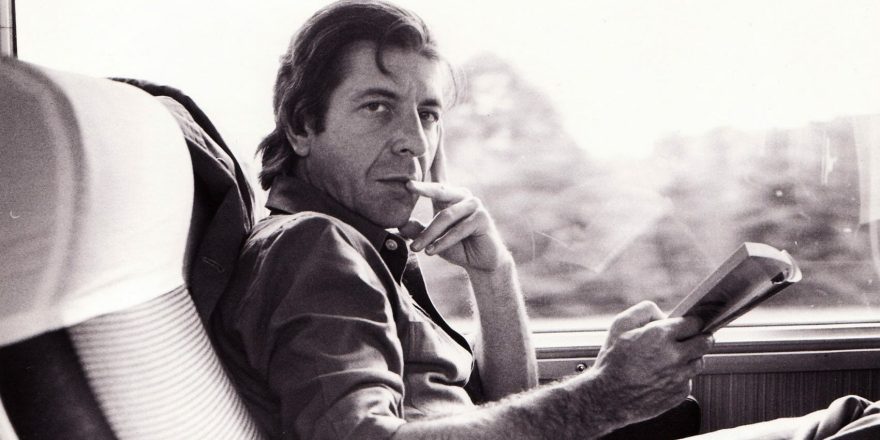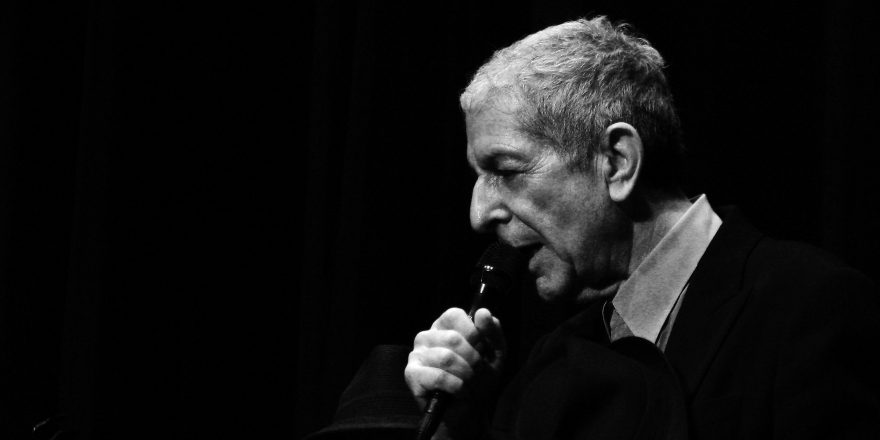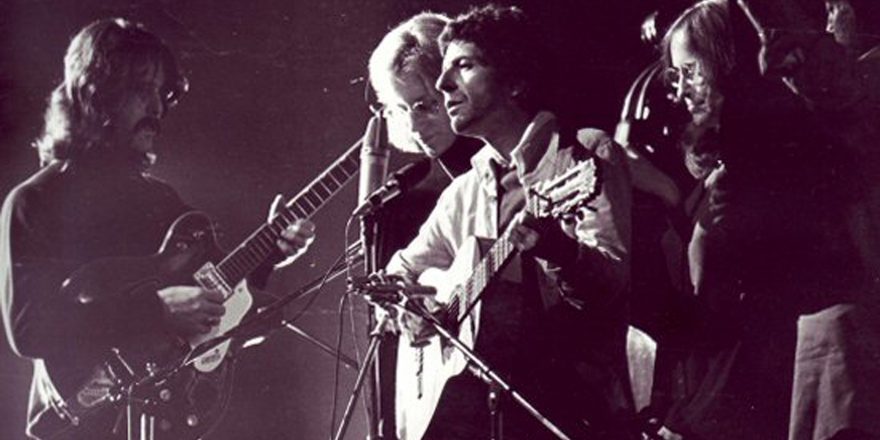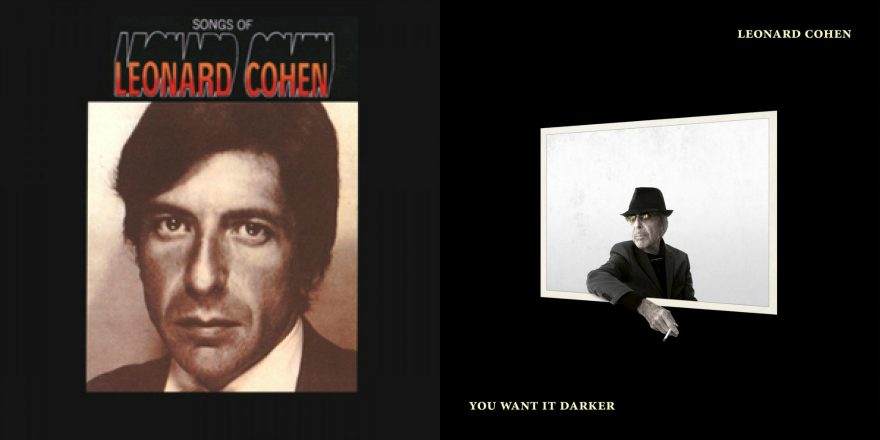Richard Reed Parry is a Montreal-based musician known for his work as a solo artist and as a multi-instrumentalist in Arcade Fire; John Zeppetelli is the Director and Chief Curator at the Musée d’art contemporain de Montréal, which hosted the first iteration of Leonard Cohen: A Crack in Everything, an exhibition dedicated to the life and work of the titular artist. Here, they discuss Cohen, the exhibit, and the artistic process.
— Annie Fell, Talkhouse Associate Editor
John Zeppetelli: We know one another, right, Richard?
Richard Reed Parry: I believe so.
John: I recall meeting you in Billy Bishop Airport in Toronto many times. We totally know one another. It’s great you were involved in the show, and it’s great that you were singing backup vocals with Ragnar Kjartansson then as well.
Richard: Oh, yeah. [Laughs.]
John: We worship Ragnar.
Richard: He just put up a show in Denmark — it’s a permanent installation in a hospital. It’s beautiful, kind of like doctors on their coffee breaks in these beautiful constructed outdoor spaces [where] it’s being projected. I happened to be in Iceland at the time that he was shooting it, so I got to have a cameo appearance.
John: Oh, amazing. I hear he’s got a new seven screen music-based installation opening at the Met at the end of May, and it involves the twin girls that were in [Ragnar’s video project] “The Visitors,” that beautiful music work. So, Richard, tell me what you thought of our show at The [Musée d’art contemporain de Montréal] — did you see it in Montreal?
Richard: Yeah, I saw it in Montreal, which is my home base, and because so many people from my own musical and artistic community were involved in that show. It really became one of those things that becomes this great rallying point for the cultural community. But then, you know, when you go off into the artistic corner, it just becomes everybody’s entire reality of your community when someone does something like this. It becomes a cornerstone of — not so much of a scene, necessarily, but [Leonard Cohen] is kind of the patron saint of being an artist in Montreal.
John: Yeah, absolutely. Of course, the Montreal version had this beautiful public program element to it where we had five concerts over the five month run, so there was a concert once a month on one album per night.
Richard: That was beautiful — all the musicians of Montreal were, like, “Hey, I have a job for five months.” [Laughs.] But that’s kind of the benefit when a cultural giant passes. It felt like such a milestone, a major moment in time, and a very beautiful way to document and expand on this kind of supernova of a life.
John: I think the timing had so much to do with it too. I mean, it was accidental timing, to be honest — I didn’t know that project was being organized two years before he died. I didn’t want to confuse my fandom and [co-curator] Victor Shiffman’s fandom with a general appreciation of Leonard Cohen, even though I felt intuitively that he was universally admired by everybody in Montreal. But when his album, You Want It Darker, came out at age 82 just a couple of weeks before he died, we felt so vindicated in what we perceived to be a somewhat unorthodox choice for a museum exhibition. You know, Leonard Cohen, a guy in his 80s with this gravelly voice.
Richard: Right, it’s not often that a musician gets to occupy a gallery like that.
John: Exactly. And then, during the organization of the show, to come out with this amazing album — we loved it, not because we were working on a Leonard Cohen show. We loved it independently of that. We thought it was a really great, beautiful, stirring, powerful work, and a lot of critics agreed with us. Then not only that, he went and died on us! Which was extremely emotional, because we were so invested and we were talking to the management on a daily basis and getting little snippets here and there about [his illness], but we had no idea it would stick. I actually discovered this when I read that profile by David Remnick in The New Yorker where it was clearly stated that he was very, very ill, terminally ill, and could barely move and was basically just whispering those songs into the microphone in his house. Even that was a heroic effort.
Richard: His son picked up the reins of the gigantic pain in the butt that it is to make an album, that the man himself couldn’t have done in that condition. Adam had the strength and the fortuity to be the guy who spearheaded the whole thing. You know, it’s a lot of work making an album, period, but also the bulk of the real work is not just making an album but making the album — making the right album that captures the real thing that’s going on there. A good album has to really know what its borders are, know what its boundaries are, know what it is and the world it’s living in, and there’s a lot of work to kind of protect those boundaries and to keep the literal voice protected and in the right company. Adam did a great job of that, and it’s such a perfect calling card to go out on as well. The man clearly he knew that he was dying, and to have his son there being the one to keep the wolves at bay, as it were.
John: That’s incredibly touching and it’s absolutely true what you’re describing. It was literally recorded in his house. Speaking of which, knowing in retrospect now that he went back for the first time to the choir from his family’s synagogue — the choir from Shaar Hashomayim makes an appearance for the very first time on this album. In his musical career, there were never any male backup vocalists, there were always women, which is why we felt we could introduce them in Candice Breitz’s “I’m Your Man,” which I’m sure you’ll remember with all those fans.
I just want to describe this project, because it was one of the big undertakings of the show — [Victor and I] really were like the line producers. We organized the call for participation and we booked the studios and we did everything for them, and happily, of course. And it needed to be a Montreal project. In “I’m Your Man (a Portrait of Leonard Cohen)” the artist basically wanted to explore Leonard and explore a new form of portraiture through Leonard Cohen’s Montreal fans. Hundreds of people applied after we sent out a call, and then she put everybody through a very rigorous selection process so you really had to prove that you were an absolutely devoted fan, and that you could sing comfortably almost from memory an entire album. But then you would have this opportunity to publicly display your love and devotion to Leonard Cohen by participating in this artwork, so hundreds of people as applied. Only 18 were selected, and these 18 were then recorded in a professional studio and literally sang the whole album from start to finish, and in the order that appears in the album of course.
It’s just such a powerful idea, because they were all men — and this was very important for her in terms of the framework of the project; they needed to be men and they needed to be 65 years of age or over, because she really wanted to capture the decades and decades of emotional investment in Leonard Cohen that they would bring to the table by being that age. Also, what I find really interesting is that you never really see that community in an artwork. Art is, you know, young and hip and gorgeous, and what have you, and it’s fantastic to see older people in art. This is not something that maybe she intended, but which struck me on many occasions going in there, and they were very much amateurs. I mean these guys sang with their hearts and it was an anthropological study because there were 18 screens that surrounded you, and you could literally spend the entire album just focusing on one person and you would learn so much about that one single person.
Then introducing the choir was such a great move, because she had done this kind of project on other musicians before; she’d done a similar version on John Lennon and one on Bob Marley and she wanted to make one on Madonna in Milan, but the difference between this project and the other ones is that she introduced a kind of musical element, so that the choir — who are in an antechamber — only sing the backup vocals, which were rearranged for this purpose. So these male voices are beautifully supporting the amateur singers on the inside. And what you have in that antechamber is you could sit happily for an hour and just listen to the negative space of the album, in a way, where Leonard’s presence is basically in the absence of the lyrics. And then they’re miked in, piped into the other space. I think it’s a really, really rich work and I’m so proud that we were able to work on that and it was very central that we were able to acquire it for the collection.
Richard: It’s great.
John: “I’m Your Man (A portrait of Leonard Cohen)” is just a really, really powerful work. Everything looks different now in New York. I mean, it’s interesting to look at stuff. We had a particular display here — it was very horizontal with these big vaulting galleries that we have, and everything was on one floor, as you remember. So you basically you had a very determined itinerary in the exhibition, and we actually built it. We build exhibitions like a narrative so that we know what the visitor will encounter first, and then in the subsequent room, and then there’s moments [where] you can either go to your left or right, but usually it’s in one direction. So we can build what we perceived was a kind of emotional narrative with lots of doors, lots of enclosed spaces.
A lot of people described it to me — and I never thought of it this way — that it was like entering Leonard’s house and every room told you something about a different aspect of his personality or his biography or his work. They were rooms with all these different gifts and perspectives. Which was then, in the Montreal version of the show, literalized in an actual room which depicted Leonard Cohen’s very modest house in Los Angeles — I don’t know if you remember that piece by the Sanchez Brothers.
Richard: Yes.
John: Sadly, not in the show in New York, because we couldn’t do them all, they’re very different spaces. So, that moment became even more powerful, because we had a feeling throughout the show that we were in various little rooms, and then there was an actual little room through a window where you can see this holographic version of Cohen in the last weeks of his life on his balcony. It was based on a photograph by Dominique Isserman, the French photographer that he was involved with for many years, who actually came to the opening. They were a couple for I believe five, six, seven years, or something. Anyway, a really, really powerful experience all around about this wonderful guiding figure of Leonard. The more you burrowed into Leonard Cohen, the more compelling he became. I thought I’d get bored, but it just it just got richer.
Richard: Sure. It’s the tapestry of life, and every life creates a world around it.
John: He was also an incredibly private person and I had a feeling, maybe, that he would object to a museum in his hometown devoting a lot of time and energy and space and resources to something about him, so it was important we got the idea right — the idea of commissioning contemporary artists to reflect on his life and on his work mainly, and not focus on elements from his [personal] life like memorabilia or hats or suits other such stuff. So it’s very touching that we got these messages back saying that Leonard was touched by the fact that younger artists not in his discipline, who are not writers and poets or musicians, would be inspired enough to want to make an art work. So, that’s what got us through.
Richard: You don’t want to turn the whole thing into a mausoleum.
John: Yeah, absolutely. It was fantastic. We needed them on board, because it would have been too ostentatious to do something without his knowledge or consent. I mean, there’s no way that we would have gone ahead had he said, “Absolutely out of the question, I really am not comfortable with this.” But thankfully Robert [Kory, Cohen’s manager], I think, convinced him that it would be all right and that Robert would take care of it all. Of course, one of the first things we also heard back, however, was that he would not come to the opening, which was really funny. [Laughs.] Then he died and I thought, he really meant it.
Richard: [Laughs.] He really meant it.
John: Naturally everybody we talked to basically was, like, “Can I have 30 seconds with Leonard? I just want to take one picture!” And that was absolutely out of the question; that was very clear from the get-go, but of course it didn’t stop us from trying. We had this one really interesting community participatory project where an artist — I won’t tell you who he is — wanted to record a melody directly from Cohen’s mouth and then transcribe that melody to the employees of the man who would then be called upon to sing the melody in the galleries. Like, literally quit work for five minutes a day and then go into the galleries and sing this melody that issued from Leonard Cohen’s mouth. But, anyway, he sadly never made it, but it was such a beautiful idea and we had pursued it for months and months and months and it never came to fruition.
Richard: That’s unfortunate, that would have been gorgeous.
John: Yeah. Thinking about it again now, I feel like maybe we could have insisted, but there was no way that we could do that. I mean, of course there was always the possibility of going to the published music or the records and just grabbing a little segment from that, but it wouldn’t have been the same.
Richard: Right.
John: And the idea was for the institution to give back to the artist in this form. You know, Richard, because you’re a musician and you make artwork, and I have such enormous respect for what you do and what artists in general do — it’s just really making yourself as vulnerable as possible, subjecting yourself to all kinds of criticisms by people. People go in and out of fashion and then you’re dismissed, and this was somebody who’d been on the scene for six decades, either as a writer or a poet or a songwriter.
Richard: And it’s very admirable to have stayed out of the scene, as it were, for big chunks of time, and devoted his life to making beautiful art.
John: It’s just really exciting to see the show in New York, and to see it in such a different setting. It’s such a buzz and a high to go into the galleries every day, to see all the people queuing; it’s just so gratifying. You work so hard at something and you never know what you’re going to come up with, with commissions, because it takes months and months to make a decision. Because once you offer the commission and the money, then you have to accompany it, and then it’s very awkward if it doesn’t come out right, and how do you say “no?” But we didn’t have that problem with anybody, thank god, but you know it’s a risk. So in many ways, we felt like we were seeing the exhibition when it first opened here in November 2017, that we were seeing the work for the first time with the first visitors. Even though we’ve followed it very intensively and knew the artists really well and did numerous studio visits around the world and all that, things never really come together until they actually come together in the galleries.
Richard: And that’s the way of all art, really.
John: Exactly, right? What’s your process in the studio with Arcade Fire? Is there tons of prep, or is a lot of stuff left to improvisation or chance?
Richard: I would say all art takes its own path, but the door is wide open for the Holy Ghost, as it were. I think you really have to do that if you want to work on something and create something that feels alive. I’m a really big fan of — Leonard Cohen said this, about how the art is just the ash and the real fire is the moment that you’re making it. Which is a beautiful sentiment, and kind of points back to the moment of process and the moment of creation as a the real thing that you’re going for. In our band, and in my solo work, we try to really set up the circumstances that feel like they would be inspiring and have enough question marks and empty spaces to explore that make you feel like you’re going somewhere and you’re presenting the world that you want to create. You leave the door wide open for the magical wind to come through. Some people are more calculated and try to plan; we plan as much as we like to create a space to be able to go where the wind takes you, and see which currents you’re gonna jump on.







